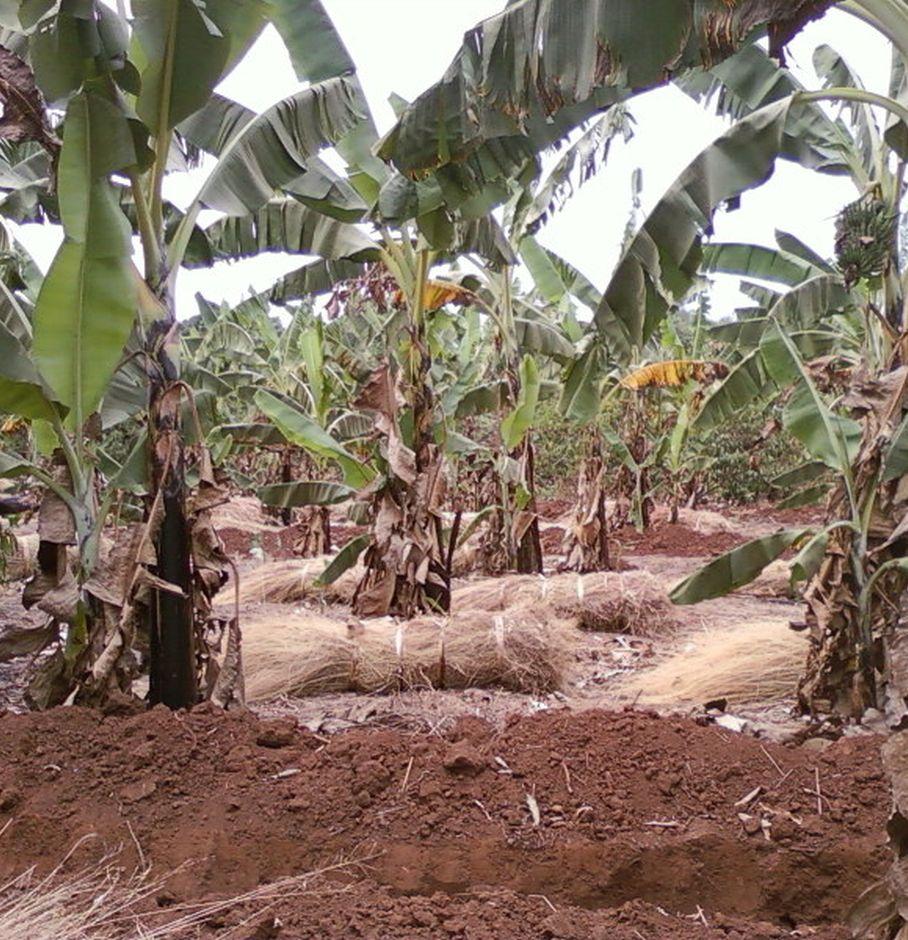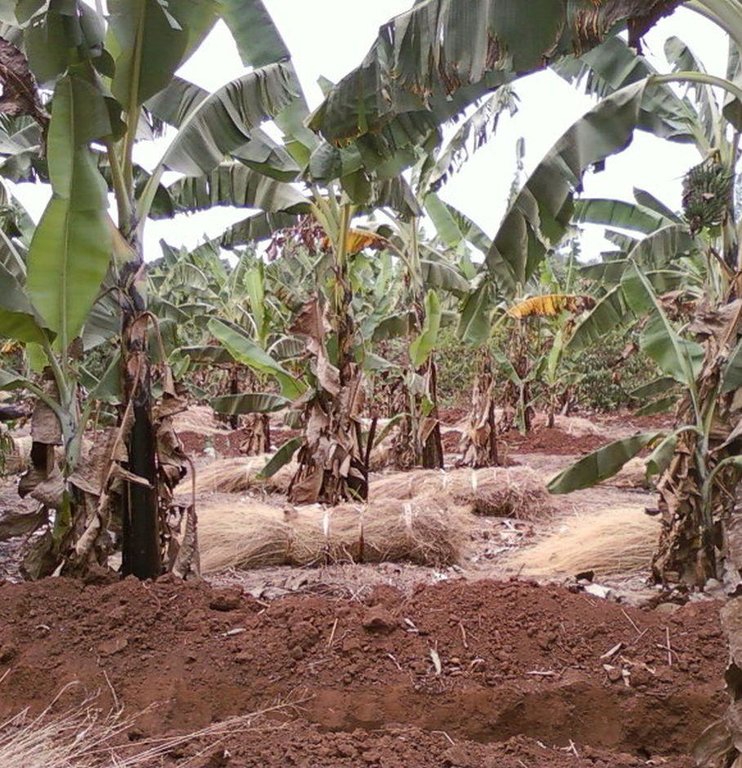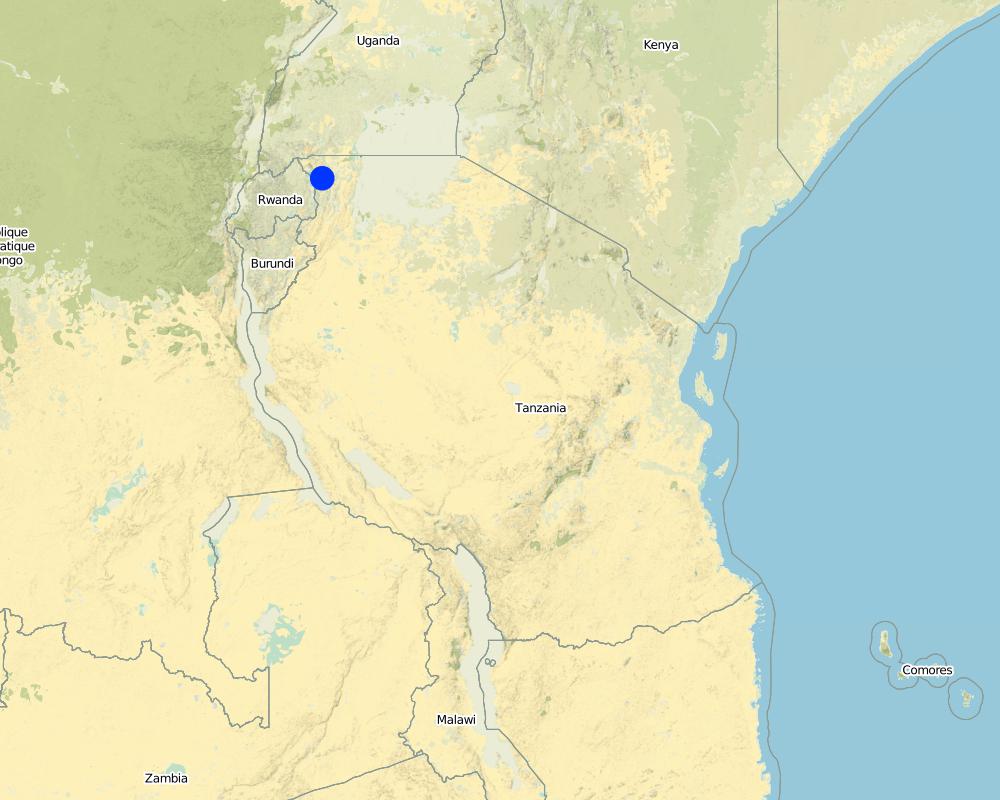Contour ditches combined with manures and mulch grass in banana production. [แทนซาเนีย]
- ผู้สร้างสรรค์:
- การอัพเดท:
- ผู้รวบรวม: Godfrey Baraba
- ผู้เรียบเรียง: –
- ผู้ตรวจสอบ: David Streiff, Alexandra Gavilano
makinga maji ya kati
technologies_1215 - แทนซาเนีย
ดูส่วนย่อย
ขยายทั้งหมด ย่อทั้งหมด1. ข้อมูลทั่วไป
1.2 รายละเอียดที่ติดต่อได้ของผู้รวบรวมและองค์กรที่เกี่ยวข้องในการประเมินและการจัดเตรียมทำเอกสารของเทคโนโลยี
ผู้เชี่ยวชาญ SLM:
ชื่อของโครงการซึ่งอำนวยความสะดวกในการทำเอกสารหรือการประเมินเทคโนโลยี (ถ้าเกี่ยวข้อง)
The Transboundary Agro-ecosystem Management Project for the Kagera River Basin (GEF-FAO / Kagera TAMP )ชื่อขององค์กรซึ่งอำนวยความสะดวกในการทำเอกสารหรือการประเมินเทคโนโลยี (ถ้าเกี่ยวข้อง)
Missenyi District Council (Missenyi District Council) - แทนซาเนียชื่อขององค์กรซึ่งอำนวยความสะดวกในการทำเอกสารหรือการประเมินเทคโนโลยี (ถ้าเกี่ยวข้อง)
Bukoba district council (Bukoba district council) - แทนซาเนีย1.3 เงื่อนไขการใช้ข้อมูลที่ได้บันทึกผ่านทาง WOCAT
ผู้รวบรวมและวิทยากรหลักยอมรับเงื่อนไขเกี่ยวกับการใช้ข้อมูลที่ถูกบันทึกผ่านทาง WOCAT:
ใช่
1.4 การเปิดเผยเรื่องความยั่งยืนของเทคโนโลยีที่ได้อธิบายไว้
เทคโนโลยีที่ได้อธิบายไว้นี้เป็นปัญหาของความเสื่อมโทรมโทรมของที่ดินหรือไม่ จึงไม่ได้รับการยอมรับว่าเป็นเทคโนโลยีเพื่อการจัดการที่ดินอย่างยั่งยืน:
ไม่ใช่
2. การอธิบายลักษณะของเทคโนโลยี SLM
2.1 การอธิบายแบบสั้น ๆ ของเทคโนโลยี
คำจำกัดความของเทคโนโลยี:
Is a cross slope berier characterised with 2m widith by 2m depth furrow, farm yard manures and grass mulch in banana production.
2.2 การอธิบายแบบละเอียดของเทคโนโลยี
คำอธิบาย:
The level ditches combined with farm trushlines, farm yard manure, and grass mulch technology in banana production is the digging of a furrow measured 2m wide by 2m deep along the contour in the banana plantation. The technology is applied on a perennial cropland by combining structural, vegetative and agronomic measures. The climatic zone is sub humid in a gentle to moderate slope with medium to deep loam clay soils. The hand cultivation is done manual using hand hoes in a mixed production system. The establishment procedures contour demarcation using a local made A-frame, digging a furrow along the contour, digging the banana holes spaced at 3.6m by 3.6m between the structures, mixing farm yard manure with top soils and planting banana suckers after restng the mixture for not less than 60 days. The maintenance procedures requires, weeding the field, desuckering, detrushing, planting beans, topical manure application, grass mulch application and filling the contour furrow with farm trushlines. The land ownership is individual not titled. This technology was introduced in 2012 by Kagera TAMP using the FFS methodology. In case of sensitive climatic extremities
Purpose of the Technology: The major purpose for technology application is reduced moisture stress, increased soil water retention, reduced soil erosion to increase crop productivity in a sustainable land management.
Establishment / maintenance activities and inputs: The establishment activities included; first to clear the field and demarcate the contour line using a local made A-frame done at the end of short rains. Second is to plough and harrow the field done in the early dry season. Third is to space and dig holes for planting banana suckers done in mid of dry season. Fourth is mixing farm yard manures with top soils and cover the hole for not less than sity days before planting, this is done in mid of dry spell. Fourth is to plant certified banana suckers done in late dry season. Fifth is to dig the contour ditch done in at the onset of long rainfall. The maintenance activities includes; first to weed the entire field done twice before the onset of rainfalls. Second is to apply farm yard manures concurrently with grass mulch done once in the late dry period. Third is to desucker and detrush banana plants done twice before planting beans. Fourth is to plant beans done once before the onset of long rainfalls.
Natural / human environment: The natural environment in the location is 750-1000 mm rainfalls, foots lopes valley floors landform, gentle slope, shallow to meium soil depth (50-80)cm and (80-120)cm characterised with two growing periods. The social economic persisting are small scale land users farming on( 0.5 to 2)ha per house hold. The land ownership is individual not titled while the water use rights is open access. The importance of off-farm incomes is less than 10% and the market orientation is mixed while soil cultivation is manual and livestock are not fed on farm residues.
2.3 รูปภาพของเทคโนโลยี
2.5 ประเทศภูมิภาค หรือสถานที่ตั้งที่เทคโนโลยีได้นำไปใช้และได้รับการครอบคลุมโดยการประเมินนี้
ประเทศ:
แทนซาเนีย
ภูมิภาค/รัฐ/จังหวัด:
Tanzania
ข้อมูลจำเพาะเพิ่มเติมของสถานที่ตั้ง :
Karagwe District Council
ระบุการกระจายตัวของเทคโนโลยี:
- กระจายไปอย่างสม่ำเสมอในพื้นที่
If precise area is not known, indicate approximate area covered:
- < 0.1 ตร.กม.(10 เฮกตาร์)
แสดงความคิดเห็น:
Three host farmers of FFS allocated a total of 1.5 acres (three different sites) as a leaning sites. While 22 group members implimented the technology with modifications in their farms with average of 0.5ha X22 =1.1ha
Map
×2.6 วันที่การดำเนินการ
ถ้าไม่รู้ปีที่แน่นอน ให้ระบุวันที่โดยประมาณ:
- น้อยกว่า 10 ปี (ไม่นานนี้)
2.7 คำแนะนำของเทคโนโลยี
ให้ระบุว่าเทคโนโลยีถูกแนะนำเข้ามาอย่างไร:
- ทางโครงการหรือจากภายนอก
ความคิดเห็น (ประเภทของโครงการ เป็นต้น) :
Introduced by TAMP -Kagera, Tanzania in 2012 using FFS methodology.
3. การจัดประเภทของเทคโนโลยี SLM
3.1 วัตถุประสงค์หลักของเทคโนโลยี
- ลด ป้องกัน ฟื้นฟู การเสื่อมโทรมของที่ดิน
3.2 ประเภทของการใช้ที่ดินในปัจจุบันที่ได้นำเทคโนโลยีไปใช้

พื้นที่ปลูกพืช
- การปลูกพืชล้มลุกอายุปีเดียว
- การปลูกพืชยืนต้นที่ไม่มีเนื้อไม้
- การปลูกไม้ยืนต้น ไม้พุ่ม
Annual cropping - Specify crops:
- cereals - maize
- legumes and pulses - beans
- root/tuber crops - sweet potatoes, yams, taro/cocoyam, other
Perennial (non-woody) cropping - Specify crops:
- banana/plantain/abaca
Tree and shrub cropping - Specify crops:
- coffee, open grown
จำนวนของฤดูเพาะปลูกต่อปี:
- 2
ระบุ:
Longest growing period in days: 90; Longest growing period from month to month: October to December; Second longest growing period in days: 60; Second longest growing period from month to month: March to May
แสดงความคิดเห็น:
Major land use problems (compiler’s opinion): The major land use problem related to soil and vegetation in the area were soil erosion, soil moisture stress and fertility decline and reduced organic matter content.
Major land use problems (land users’ perception): moisture stresss and soil erosion.
3.4 การใช้น้ำ
การใช้น้ำของที่ดินที่มีการใช้เทคโนโลยีอยู่:
- จากน้ำฝน
3.5 กลุ่ม SLM ที่ตรงกับเทคโนโลยีนี้
- การปรับปรุงดิน / พืชคลุมดิน
- การจัดการความอุดมสมบรูณ์ของดินแบบผสมผสาน
3.6 มาตรการ SLM ที่ประกอบกันเป็นเทคโนโลยี

มาตรการจัดการพืช
- A2: อินทรียวัตถุในดิน/ความอุดมสมบูรณ์ในดิน
- A3: การรักษาหน้าดิน

มาตรการอนุรักษ์ด้วยวิธีพืช
- V5: อื่นๆ

มาตรการอนุรักษ์ด้วยโครงสร้าง
- S2: ทำนบ เขื่อนดิน
แสดงความคิดเห็น:
Specification of other vegetative measures: lemon grass
Type of agronomic measures: better crop cover, mulching, temporary trashlines, manure / compost / residues
Type of vegetative measures: aligned: -contour, scattered / dispersed
3.7 รูปแบบหลักของการเสื่อมโทรมของที่ดินที่ได้รับการแก้ไขโดยเทคโนโลยี

การกัดกร่อนของดินโดยน้ำ
- Wt (Loss of topsoil): การสูญเสียดินชั้นบนหรือการกัดกร่อนที่ผิวดิน

การเสื่อมโทรมของดินทางด้านเคมี
- Cn (Fertility decline): ความอุดมสมบูรณ์และปริมาณอินทรียวัตถุในดินถูกทำให้ลดลงไป (ไม่ได้เกิดจากสาเหตุการกัดกร่อน)

การเสื่อมโทรมของดินทางด้านชีวภาพ
- Bl (Loss of soil life): การสูญเสียสิ่งมีชีวิตในดิน
แสดงความคิดเห็น:
Main causes of degradation: soil management (cultivating along the slopes), crop management (annual, perennial, tree/shrub) (continous banana production without soil fertilization.), change of seasonal rainfall (dry spell prolonged), droughts (the area experienced a six months dry period.), population pressure (High population growth rates had forced to cultivate slope lands to feed the population.), poverty / wealth (community cant afford to invest in soil conservation.), education, access to knowledge and support services (inadequate staffing reduces extension services rendered to farmes.), governance / institutional (Agriculture policy had a narrow focus on environmental issues.)
3.8 การป้องกัน การลดลง หรือการฟื้นฟูความเสื่อมโทรมของที่ดิน
ระบุเป้าหมายของเทคโนโลยีกับความเสื่อมโทรมของที่ดิน:
- ป้องกันความเสื่อมโทรมของที่ดิน
- ลดความเสื่อมโทรมของดิน
4. ข้อมูลจำเพาะด้านเทคนิค กิจกรรมการนำไปปฏิบัติใช้ ปัจจัยนำเข้า และค่าใช้จ่าย
4.1 แบบแปลนทางเทคนิคของเทคโนโลยี
ข้อมูลจำเพาะด้านเทคนิค (แบบแปลนทางเทคนิคของเทคโนโลยี):
Technical knowledge required for field staff / advisors: low (Basic agronomy principles, farm structures and vegetation management are taught at colleges.)
Technical knowledge required for land users: low (most of material required to implement the technology are common to them.)
Main technical functions: control of raindrop splash, control of dispersed runoff: retain / trap, control of dispersed runoff: impede / retard, improvement of ground cover, stabilisation of soil (eg by tree roots against land slides), increase in organic matter, increase in nutrient availability (supply, recycling,…), increase of infiltration, increase / maintain water stored in soil, increase of biomass (quantity)
Better crop cover
Material/ species: Pumpukins and water melon
Remarks: spaced at 3m in the space between the contour bunds.
Mulching
Material/ species: hyperhamia spps
Quantity/ density: 1500
Remarks: spread across the slope with 15cm thick covering the soil surfaces where banana and coffee are plant
Temporary trashlines
Material/ species: banana dry leaves and psodstems.
Manure / compost / residues
Material/ species: farm yard manures
Quantity/ density: 48979
Remarks: 60kg per plant during planting and 36kg for maintenance.
Aligned: -contour
Vegetative material: G : grass
Number of plants per (ha): 1666
Spacing between rows / strips / blocks (m): 18
Vertical interval within rows / strips / blocks (m): 0.6
Width within rows / strips / blocks (m): 0.3
Scattered / dispersed
Vegetative material: O : other
Number of plants per (ha): 778
Structural measure: contour bund
Spacing between structures (m): 18
Depth of ditches/pits/dams (m): 0.6
Width of ditches/pits/dams (m): 0.6
Length of ditches/pits/dams (m): 100
Height of bunds/banks/others (m): 0.3
Width of bunds/banks/others (m): 0.6
Length of bunds/banks/others (m): 100
Construction material (earth): soils excavated from the furrow.
4.2 ข้อมูลทั่วไปเกี่ยวกับการคำนวณปัจจัยนำเข้าและค่าใช้จ่าย
ระบุสกุลเงินที่ใช้คำนวณค่าใช้จ่าย:
- USD
ระบุค่าเฉลี่ยของค่าจ้างในการจ้างแรงงานต่อวัน:
2.64
4.3 กิจกรรมเพื่อการจัดตั้ง
| กิจกรรม | Timing (season) | |
|---|---|---|
| 1. | To plant lemon grass | March |
| 2. | To plant water melon | april |
| 3. | To gape fill lemon grasse | september |
| 4. | Dermacating the contour lines using simple made tool (A-frame) | June |
| 5. | To dig a furrow and excavating the soils to be placed on either lower side or upper side of the furrow. | August |
4.4 ค่าใช้จ่ายของปัจจัยนำเข้าที่จำเป็นสำหรับการจัดตั้ง
| ปัจจัยนำเข้า | หน่วย | ปริมาณ | ค่าใช้จ่ายต่อหน่วย | ค่าใช้จ่ายทั้งหมดต่อปัจจัยนำเข้า | %ของค่าใช้จ่ายที่ก่อให้เกิดขึ้นโดยผู้ใช้ที่ดิน | |
|---|---|---|---|---|---|---|
| แรงงาน | Labour | ha | 1.0 | 609.45 | 609.45 | |
| อุปกรณ์ | Tools | ha | 1.0 | 114.71 | 114.71 | |
| วัสดุด้านพืช | Seedlings | ha | 1.0 | 420.17 | 420.17 | |
| ปุ๋ยและสารฆ่า/ยับยั้งการเจริญเติบโตของสิ่งมีชีวิต (ไบโอไซด์) | Compost / manure | ha | 1.0 | 756.3 | 756.3 | |
| ค่าใช้จ่ายทั้งหมดของการจัดตั้งเทคโนโลยี | 1900.63 | |||||
| Total costs for establishment of the Technology in USD | 1900.63 | |||||
แสดงความคิดเห็น:
Duration of establishment phase: 12 month(s)
4.5 การบำรุงรักษาสภาพหรือกิจกรรมที่เกิดขึ้นเป็นประจำ
| กิจกรรม | ช่วงระยะเวลา/ความถี่ | |
|---|---|---|
| 1. | Weeding in the space where coffee and banana are planted. | january and June |
| 2. | desuckering | February and August |
| 3. | Detrushing | February and August |
| 4. | manure application | July |
| 5. | Spreading mulch grasses | September |
| 6. | Harvesting banana and coffee. | routeenly |
| 7. | To harvest lemon grass | routeenly |
| 8. | To remove soil sedments from the furrow and place them along the contour lines. | june and January. |
4.6 ค่าใช้จ่ายของปัจจัยนำเข้าและกิจกรรมที่เกิดขึ้นเป็นประจำที่ต้องการการบำรุงรักษา (ต่อปี)
| ปัจจัยนำเข้า | หน่วย | ปริมาณ | ค่าใช้จ่ายต่อหน่วย | ค่าใช้จ่ายทั้งหมดต่อปัจจัยนำเข้า | %ของค่าใช้จ่ายที่ก่อให้เกิดขึ้นโดยผู้ใช้ที่ดิน | |
|---|---|---|---|---|---|---|
| แรงงาน | Labour | ha | 1.0 | 416.91 | 416.91 | 100.0 |
| วัสดุด้านพืช | Seeds | ha | 1.0 | 88.24 | 88.24 | 100.0 |
| ปุ๋ยและสารฆ่า/ยับยั้งการเจริญเติบโตของสิ่งมีชีวิต (ไบโอไซด์) | Compost / manure | ha | 1.0 | 252.1 | 252.1 | 100.0 |
| ปุ๋ยและสารฆ่า/ยับยั้งการเจริญเติบโตของสิ่งมีชีวิต (ไบโอไซด์) | Grass mulch | ha | 1.0 | 441.18 | 441.18 | 100.0 |
| ค่าใช้จ่ายทั้งหมดของการบำรุงรักษาสภาพเทคโนโลยี | 1198.43 | |||||
| Total costs for maintenance of the Technology in USD | 1198.43 | |||||
แสดงความคิดเห็น:
Labour calculated per ha of land protected, Farm yard manure calculated per plants applied, mulch grass calculated per ha of land protected, seedling and seeds calculated per ha of land protected.
4.7 ปัจจัยสำคัญที่สุดที่มีผลกระทบต่อค่าใช้จ่าย
ปัจจัยสำคัญที่สุดที่มีผลกระทบต่อค่าใช้จ่ายต่างๆ:
The most determinate factor affecting the cost is labour
5. สิ่งแวดล้อมทางธรรมชาติและของมนุษย์
5.1 ภูมิอากาศ
ฝนประจำปี
- < 250 ม.ม.
- 251-500 ม.ม.
- 501-750 ม.ม.
- 751-1,000 ม.ม.
- 1,001-1,500 ม.ม.
- 1,501-2,000 ม.ม.
- 2,001-3,000 ม.ม.
- 3,001-4,000 ม.ม.
- > 4,000 ม.ม.
เขตภูมิอากาศเกษตร
- กึ่งชุ่มชื้น
Thermal climate class: tropics
5.2 สภาพภูมิประเทศ
ค่าเฉลี่ยความลาดชัน:
- ราบเรียบ (0-2%)
- ลาดที่ไม่ชัน (3-5%)
- ปานกลาง (6-10%)
- เป็นลูกคลื่น (11-15%)
- เป็นเนิน (16-30%)
- ชัน (31-60%)
- ชันมาก (>60%)
ธรณีสัณฐาน:
- ที่ราบสูง/ที่ราบ
- สันเขา
- ไหล่เขา
- ไหล่เนินเขา
- ตีนเนิน
- หุบเขา
ระดับความสูง:
- 0-100 เมตร
- 101-500 เมตร
- 501-1,000 เมตร
- 1,001-1,500 เมตร
- 1,501-2,000 เมตร
- 2,001-2,500 เมตร
- 2,501-3,000 เมตร
- 3,001-4,000 เมตร
- > 4,000 เมตร
5.3 ดิน
ค่าเฉลี่ยความลึกของดิน:
- ตื้นมาก (0-20 ซ.ม.)
- ตื้น (21-50 ซ.ม.)
- ลึกปานกลาง (51-80 ซ.ม.)
- ลึก (81-120 ซ.ม.)
- ลึกมาก (>120 ซ.ม.)
เนื้อดิน (ดินชั้นบน):
- ปานกลาง (ดินร่วน ทรายแป้ง)
อินทรียวัตถุในดิน:
- ปานกลาง (1-3%)
(ถ้ามี) ให้แนบคำอธิบายเรื่องดินแบบเต็มหรือระบุข้อมูลที่มีอยู่ เช่น ชนิดของดิน ค่า pH ของดินหรือความเป็นกรดของดิน ความสามารถในการแลกเปลี่ยนประจุบวก ไนโตรเจน ความเค็ม เป็นต้น:
Soil fertility is medium
Soil drainage / infiltration is medium
Soil water storage capacity is medium
5.4 ความเป็นประโยชน์และคุณภาพของน้ำ
น้ำไหลบ่าที่ผิวดิน:
เกินพอ
คุณภาพน้ำ (ที่ยังไม่ได้บำบัด):
เป็นน้ำเพื่อการดื่มที่ดี
ความคิดเห็นและข้อมูลจำเพาะเพิ่มเติมเรื่องคุณภาพและปริมาณน้ำ:
Availability of surface water: Excess during short rainfals and medium because two permanent river tributaries (misheke and Charuhanga) flows throughout the year.
Water quality (untreated): Good drinking water when gravity water supply from Kasunkuni river tributar and poor when over-flooded Mwisa river during short rains.
5.5 ความหลากหลายทางชีวภาพ
ความหลากหลายทางชนิดพันธุ์:
- ปานกลาง
ความคิดเห็นและข้อมูลจำเพาะเพิ่มเติมของความหลากหลายทางชีวภาพ:
Mchwa, sisimizi, vipepeo and earth worms
5.6 ลักษณะของผู้ใช้ที่ดินที่นำเทคโนโลยีไปปฏิบัติใช้
แนวทางการตลาดของระบบการผลิต:
- mixed (subsistence/ commercial)
รายได้ที่มาจากนอกฟาร์ม:
- < 10% ของรายได้ทั้งหมด
ระดับของความมั่งคั่งโดยเปรียบเทียบ:
- จน
- พอมีพอกิน
เป็นรายบุคคล/ครัวเรือน:
- เป็นรายบุคคล/ครัวเรือน
ระดับของการใช้เครื่องจักรกล:
- งานที่ใช้แรงกาย
เพศ:
- หญิง
- ชาย
ระบุลักษณะอื่นๆที่เกี่ยวข้องของผู้ใช้ที่ดิน:
Land users applying the Technology are mainly common / average land users
Population density: 50-100 persons/km2
Annual population growth: < 0.5%
99% of the land users are average wealthy and own 100% of the land.
1% of the land users are poor.
Off-farm income specification: Land users who applied the technolgy can meet hie/her cost of living (mainly food) from farm income while land users who have not applied the technology can not the household cost of living from the farm.
Market orientation of production system: Coffee are for sale while banana only excess is for sale.
Level of mechanization: Hand hoes use during farm establishment, but late local made tool (vihosho) are used for weeding and desuckering purpoes.
5.7 Average area of land used by land users applying the Technology
- < 0.5 เฮกตาร์
- 0.5-1 เฮกตาร์
- 1-2 เฮกตาร์
- 2-5 เฮกตาร์
- 5-15 เฮกตาร์
- 15-50 เฮกตาร์
- 50-100 เฮกตาร์
- 100-500 เฮกตาร์
- 500-1,000 เฮกตาร์
- 1,000-10,000 เฮกตาร์
- >10,000 เฮกตาร์
พิจารณาว่าเป็นขนาดเล็ก กลาง หรือขนาดใหญ่ (ซึ่งอ้างอิงถึงบริบทระดับท้องถิ่น):
- ขนาดเล็ก
แสดงความคิดเห็น:
< 0.5 and 0.5-1 ha: 75 % of landusers
2-5 ha: 25 percent of landusers
5.8 กรรมสิทธิ์ในที่ดิน สิทธิในการใช้ที่ดินและสิทธิในการใช้น้ำ
กรรมสิทธิ์ในที่ดิน:
- รายบุคคล ไม่ได้รับสิทธิครอบครอง
สิทธิในการใช้ที่ดิน:
- เกี่ยวกับชุมชน (ถูกจัดระเบียบ)
- รายบุคคล
สิทธิในการใช้น้ำ:
- เข้าถึงได้แบบเปิด (ไม่ได้จัดระเบียบ)
5.9 การเข้าถึงบริการและโครงสร้างพื้นฐาน
สุขภาพ:
- จน
- ปานกลาง
- ดี
การศึกษา:
- จน
- ปานกลาง
- ดี
ความช่วยเหลือทางด้านเทคนิค:
- จน
- ปานกลาง
- ดี
การจ้างงาน (เช่น ภายนอกฟาร์ม):
- จน
- ปานกลาง
- ดี
ตลาด:
- จน
- ปานกลาง
- ดี
พลังงาน:
- จน
- ปานกลาง
- ดี
ถนนและการขนส่ง:
- จน
- ปานกลาง
- ดี
น้ำดื่มและการสุขาภิบาล:
- จน
- ปานกลาง
- ดี
บริการด้านการเงิน:
- จน
- ปานกลาง
- ดี
6. ผลกระทบและสรุปคำบอกกล่าว
6.1 ผลกระทบในพื้นที่ดำเนินการ (On-site) จากการใช้เทคโนโลยี
ผลกระทบทางด้านเศรษฐกิจและสังคม
การผลิต
การผลิตพืชผล
แสดงความคิดเห็น/ระบุ:
Not yet harvested the first yield
การเสี่ยงต่อความล้มเหลวในการผลิต
แสดงความคิดเห็น/ระบุ:
Mulch grass have reduced moisture stresses
รายได้และค่าใช้จ่าย
ค่าใช่จ่ายของปัจจัยการผลิตทางการเกษตร
แสดงความคิดเห็น/ระบุ:
Farm yard manures, mulch grasses, lemon seedlings, certified banana suckers and water melon seed
ความหลากหลายของแหล่งผลิตรายได้
แสดงความคิดเห็น/ระบุ:
Lemon grasses and pumpukins sales
ภาระงาน
แสดงความคิดเห็น/ระบุ:
Additional activies should demamnd more labours
ผลกระทบด้านสังคมวัฒนธรรมอื่น ๆ
ความมั่นคงด้านอาหาร / พึ่งตนเองได้
แสดงความคิดเห็น/ระบุ:
Increased food production should ensure availability, while sale of coffee should ensure accebility to balance the diet
สถาบันของชุมชน
แสดงความคิดเห็น/ระบุ:
FFS group members
สถาบันแห่งชาติ
แสดงความคิดเห็น/ระบุ:
Out-soucing of activities to TCRA
SLM หรือความรู้เรื่องความเสื่อมโทรมของที่ดิน
แสดงความคิดเห็น/ระบุ:
Udelt learning using FFS methodology
สถานการณ์ของกลุ่มด้อยโอกาส ทางด้านสังคมและเศรษฐกิจ
แสดงความคิดเห็น/ระบุ:
Three group members have no land, male and female have equal chances in the group
ผลกระทบด้านนิเวศวิทยา
วัฐจักรน้ำหรือน้ำบ่า
น้ำไหลบ่าที่ผิวดิน
แสดงความคิดเห็น/ระบุ:
Mulch grasses and contour bung
การระเหย
แสดงความคิดเห็น/ระบุ:
Mulch grasses
ดิน
ความชื้นในดิน
แสดงความคิดเห็น/ระบุ:
Mulch grasses
สิ่งปกคลุมดิน
แสดงความคิดเห็น/ระบุ:
Mulch grass and pumpukins
การสูญเสียดิน
แสดงความคิดเห็น/ระบุ:
Lemon grasse planted along the contour bunds
อินทรียวัตถุในดิน/ต่ำกว่าดินชั้น C
แสดงความคิดเห็น/ระบุ:
Farm yard manures application
ความหลากหลายทางชีวภาพของพืชและสัตว์
มวลชีวภาพ/เหนือดินชั้น C
แสดงความคิดเห็น/ระบุ:
Mulch grass and trushlines
การจัดการศัตรูพืชและโรคพืช
แสดงความคิดเห็น/ระบุ:
Use of certicefid banana suckers
ลดความเสี่ยงของภัยพิบัติ
ความเสี่ยงจากไฟ
แสดงความคิดเห็น/ระบุ:
Attention for grasses collection before fire seting on has increased
6.2 ผลกระทบนอกพื้นที่ดำเนินการ (Off-site) จากการใช้เทคโนโลยี
ความเสียหายต่อพื้นที่เพาะปลูกของเพื่อนบ้าน
แสดงความคิดเห็น/ระบุ:
Water run-off reduction
ความเสียหายต่อโครงสร้างพื้นฐานของรัฐหรือของเอกชน
แสดงความคิดเห็น/ระบุ:
No longer concentrated run-off
6.3 การเผชิญและความตอบสนองของเทคโนโลยีต่อการเปลี่ยนแปลงสภาพภูมิอากาศที่ค่อยเป็นค่อยไป และสภาพรุนแรงของภูมิอากาศ / ภัยพิบัติ (ที่รับรู้ได้โดยผู้ใช้ที่ดิน)
สภาพรุนแรงของภูมิอากาศ (ภัยพิบัติ)
ภัยพิบัติทางอุตุนิยมวิทยา
| เทคโนโลยีมีวิธีการรับมืออย่างไร | |
|---|---|
| พายุฝนประจำท้องถิ่น | ไม่ค่อยดี |
ภัยพิบัติจากสภาพภูมิอากาศ
| เทคโนโลยีมีวิธีการรับมืออย่างไร | |
|---|---|
| ภัยจากฝนแล้ง | ดี |
แสดงความคิดเห็น:
The technology can be modified of metre drain and the collected water to be used for small scale irrigation.
6.4 การวิเคราะห์ค่าใช้จ่ายและผลประโยชน์ที่ได้รับ
ผลประโยชน์ที่ได้รับเปรียบเทียบกับค่าใช้จ่ายในการจัดตั้งเป็นอย่างไร (จากมุมมองของผู้ใช้ที่ดิน)
ผลตอบแทนระยะสั้น:
เป็นกลางหรือสมดุล
ผลตอบแทนระยะยาว:
ด้านบวกอย่างมาก
ผลประโยชน์ที่ได้รับเปรียบเทียบกับค่าใช้จ่ายในการบำรุงรักษาหรือต้นทุนที่เกิดขึ้นซ้ำอีก เป็นอย่างไร (จากมุมมองของผู้ใช้ที่ดิน)
ผลตอบแทนระยะสั้น:
ด้านลบ
ผลตอบแทนระยะยาว:
ด้านบวก
แสดงความคิดเห็น:
In the short term returns banana harvested should equate the establishment costs, while in the long term retuns there will be no further establishment, therefore returns are very positive.
in the short term retuns negative compared to maintenance because all returns equate establishment costs, while in the longterm returns should be positive due to complimentary effects of protected land to improve productivity.
6.5 การปรับตัวของเทคโนโลยี
- > 50%
ถ้ามีข้อมูลให้บอกปริมาณด้วย (จำนวนของครัวเรือนหรือครอบคลุมพื้นที่):
70 households in an area of 10 ha
Of all those who have adopted the Technology, how many did so spontaneously, i.e. without receiving any material incentives/ payments?
- 11-50%
แสดงความคิดเห็น:
35 land user families have adopted the Technology with external material support
Comments on acceptance with external material support: Three host farmers were provided with farm yard manures and mulch grasses.
35 land user families have adopted the Technology without any external material support
Comments on spontaneous adoption: The FFS started late due to inadequate council staffing.
There is no trend towards spontaneous adoption of the Technology
Comments on adoption trend: Still early to give any comments (actual implimentation started September 2013.
6.7 จุดแข็ง / ข้อได้เปรียบ / โอกาสของเทคโนโลยี
| จุดแข็ง / ข้อได้เปรียบ / โอกาสในทัศนคติของผู้รวบรวมหรือวิทยากรหลัก |
|---|
| The technology is easy to learn and simple to implement. |
| Production results are of short gestation period when considering test crop (banana) for land users to make the decisions. |
6.8 จุดอ่อน / ข้อเสียเปรียบ / ความเสี่ยงของเทคโนโลยีและวิธีการแก้ไข
| จุดอ่อน / ข้อเสียเปรียบ / ความเสี่ยงในทัศนคติของผู้รวบรวมหรือวิทยากรหลัก | มีวิธีการแก้ไขได้อย่างไร |
|---|---|
| The technology increased the farm input (farm yard manures and grass mulch) costs of which average land users (peasants) can not afford from his farm income on top of meeting his daily cost of living. | Introduce zero grazing to provide farm yard manures and quick income generating activities. |
| Big land area is require to realise the ecological benefits. | Sensitize political will to stimulate and support technology up scaling through multiplier effects. |
7. การอ้างอิงและการเชื่อมต่อ
7.1 วิธีการและแหล่งข้อมูล
- ไปเยี่ยมชมภาคสนาม การสำรวจพื้นที่ภาคสนาม
- การสัมภาษณ์กับผู้ใช้ที่ดิน
วันที่เก็บรวบรวมข้อมูล(ภาคสนาม) :
30/07/2014
ลิงก์และโมดูล
ขยายทั้งหมด ย่อทั้งหมดลิงก์
ไม่มีลิงก์
โมดูล
ไม่มีโมดูล




